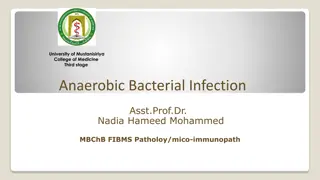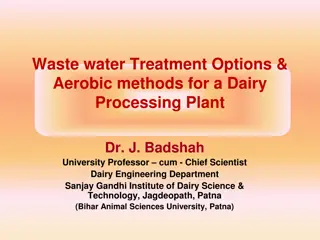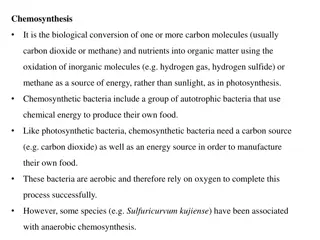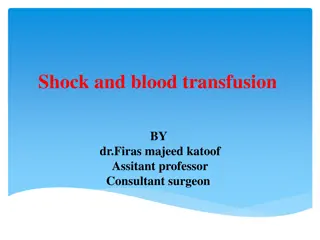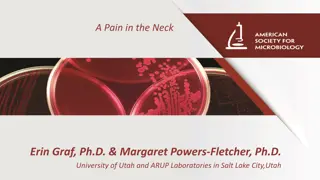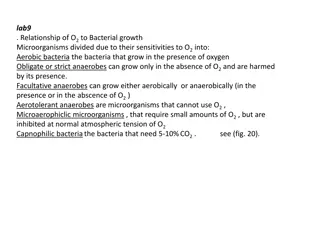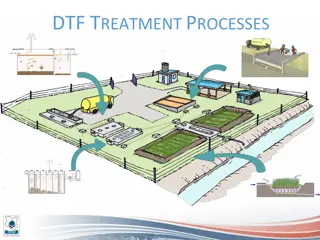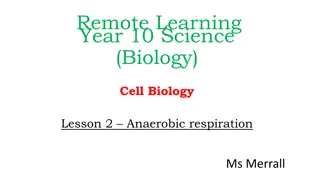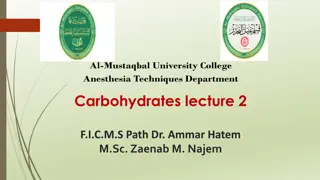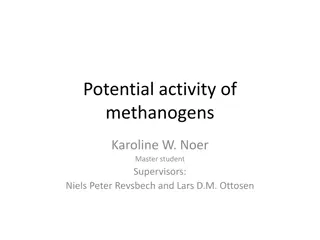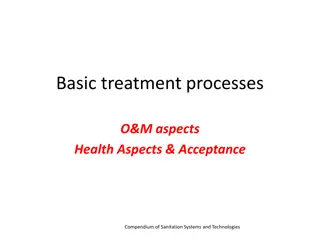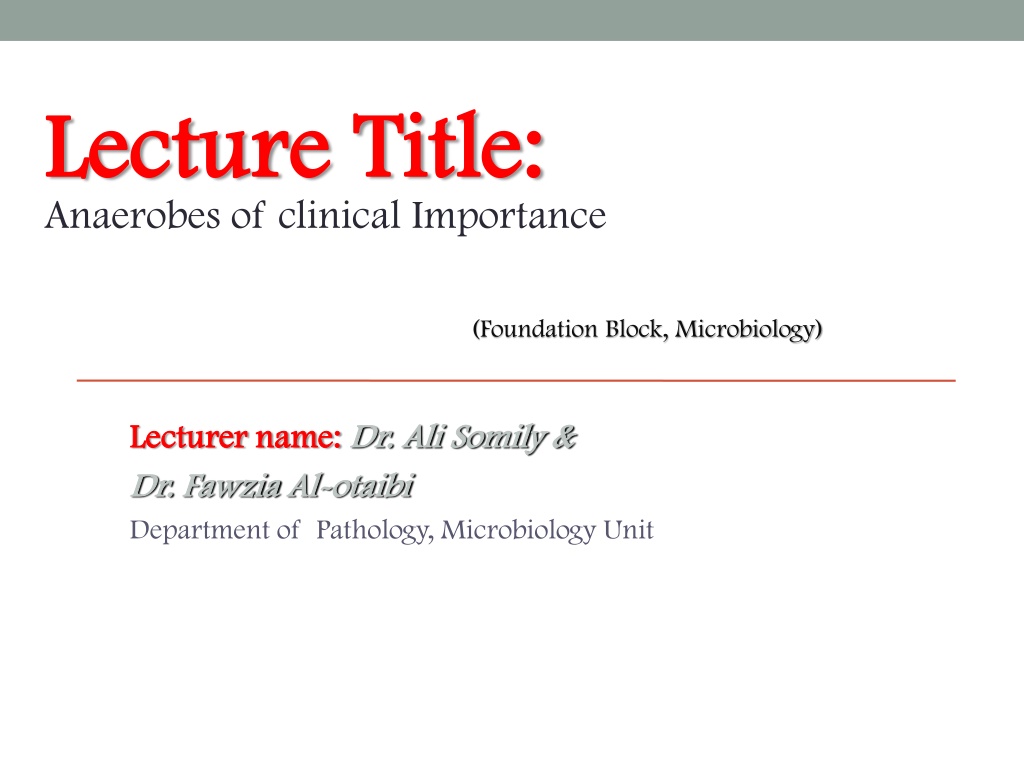
Anaerobes of Clinical Importance in Microbiology Lecture
Explore the world of anaerobic bacteria, their significance in human health, and their classification through this informative lecture. Understand their habitats, sensitivity to oxygen, and involvement in various infections. Discover the objectives, classification, and characteristics of anaerobes as you delve into the fascinating realm of microbiology.
Uploaded on | 0 Views
Download Presentation

Please find below an Image/Link to download the presentation.
The content on the website is provided AS IS for your information and personal use only. It may not be sold, licensed, or shared on other websites without obtaining consent from the author. Download presentation by click this link. If you encounter any issues during the download, it is possible that the publisher has removed the file from their server.
E N D
Presentation Transcript
Lecture Title: Lecture Title: Anaerobes of clinical Importance (Foundation Block, Microbiology) Lecturer name: Lecturer name: Dr. Ali Somily & Dr. Ali Somily & Dr. Dr. Fawzia Fawzia Al Al- -otaibi otaibi Department of Pathology, Microbiology Unit
LECTURE OBJECTIVES By the end of this lecture the student should be able to: By the end of this lecture the student should be able to: Describe anaerobic bacteria including their sensitivity to oxygen and where they may be found in the environment and the human body. Differentiate the various types of anaerobes with regard to atmospheric requirement (i.e. obligate anaerobes, Facultative anaerobes and aerotolerent anaerobes. Describe how anaerobes, as part of endogenous microbiota, initiate and establish infection. Name the endogenous anaerobes commonly involved in human infection.
LECTURE OBJECTIVES Recognize specimens that are acceptable and unacceptable for anaerobic culture. Give the clues(sign and manifestations) to anaerobic infection, name the most probable etiologic agents of the following(Wound botulism, gas gangrene,tetanus,Actinomycosis,Pseudomembranous colitis and bacterial vaginosis) Describe the microscopic and colony morphology and the results of differentiating anaerobic isolates. Discuss antimicrobial susceptibility testing of anaerobes including methods and antimicrobial agents to be tested. Describe the major approaches to treat anaerobic-associated diseases either medical or surgical.
CLASSIFICATION Anaerobes Bacilli Cocci Spore forming Non-spore forming Gram Positive Gram Negative Chains Cluster peptococcus Diplococci veillonella Gram Positive clostridium Gram Negative Bacteroides Gram Positive actinomyces peptostreptococcus
ANAEROBIOSIS ANAEROBIOSIS Contain flavoprotein so in the presence of oxygen produce H2O2 which is toxic Lack cytochrome -cannot use oxygen as hydrogen acceptor Most Lack Catalase & Peroxidase Some lack enzyme superoxide dismutase so many killed Peroxide and toxic radicles enzyme like fumarate reductase must be in reduced form to work
HABITAT : HABITAT : These organism are normal flora in: A. Oropharynx eg. Fusobacteria 1. Provetella melaninogenicus 2. Veillonella 2. B. Gastrointestinal tract Found mainly in the large colon in large numbers Total number of anaerobes = 10 11 While all aerobes (including E. coli) = 10 14 examples are Bacteroides fragilis 1. Bifidobacterium species 2. C. Female genital tract (mainly in the vagina)
FEATURES OF ANAEROBIC INFECTIONS FEATURES OF ANAEROBIC INFECTIONS Infections Infections are always near to the site of the body which are are always near to the site of the body which are habitat. habitat. Infection from animal bites. 1. Deep abscesses 2. The infections are also polymicrobial 3. Gas formation, foul smell 4. Detection of "Sulphur granules"' due to actinomycosis 5. Failure to grow organism from pus if not culture anaerobically. 6. Failure to respond to usual antibiotics. 7.
HOW DOES THE INFECTION BEGIN ? Disruption in barrier Trauma Surgery Cancer Disruption in blood supply Drop in O2 content of tissue. Decrease in Eh potential Tissue necrosis
WHAT ARE THE INFECTION CAUSED BY WHAT ARE THE INFECTION CAUSED BY THESE ANAEROBIC ORGANISMS I THESE ANAEROBIC ORGANISMS I Post operative wound infection Brain, dental, lung abscess Intra abdominal abscess, appendicitis, diverculitis Infection of the female genital tract: Septic abortion, puerperal infection and endometritis , pelvic abscess or breast abscess Diabetic foot infections and pilonidal sinus
LABORATORY DIAGNOSIS: LABORATORY DIAGNOSIS: When anaerobic infection is suspected; a) Specimens have to be collected from the site containing necrotic tissue. b) Pus is better than swabs. c) Specimens has to be send to the laboratory within 1/2 hour why? d) Fluid media like cooked meat broth are the best culture media. e) Specimens have to incubated anaerobically for 48 hours.
TREATMENT: TREATMENT: Bacteroides fragilis is always resistant to penicillin. But penicillin can he used for other anaerobes Flagyl (metronidazole) is the drug of choice. Clindamycin can also be used.
ANAEROBIC NON SPORE FORMING GRAM POSITIVE BACILLI ORGANISM DISEASE ACTINOMYCOSIS ACTINOMYCES SPP ACNE PROPIONIBACTERIUM SPP MOBILUNCUS SPP BACTERIAL VAGINOSIS ENDOCARDITIS LACTOBACILLUS SPP - EUBACTERIUM SPP - BIFIDOBACTERIUM SPP
ACTINOMYCOSIS Actinomyces are branching anaerobic or microaerophilic Gram positive bacilli Source of the infection is normal flora and the host usually normal host Primary site of the infection is mouth, lung, appendix, uterus with IUD (chronic infection) Infection can spread to the brain, liver, bone and blood Diagnosis by Gram stain with sulfur granules and growth of molar tooth colonies Treatment penicillin, clindamycin or tetracycline
ANAEROBIC GRAM NEGATIVE BACILLI BACTEROIDES BACTEROIDES FUSOBACTERIUM FUSOBACTERIUM BUTYRIVIBRIO SUCCINOMONAS
STRICT ANAEROBE PLEOMORPHIC (COCCO BACILLI)GRAM NEGATIVE BACILLI BACTEROIDES SPECIES OTHER BACTEROIDES SPECIES OTHER THAN B. FRAGILIS GROUP THAN B. FRAGILIS GROUP BACTEROIDES FRAGILLIS GROUP BACTEROIDES FRAGILLIS GROUP ACCOUNT FOR 1/3 OF ALL ISOLATES GIT TRAC LESS COMMON ORAL CAVITY B. FRAGILIS-B. VULGARIS-B.THETAIOTAMICRON B. UNIFORMIS PREVOTELLA PORPHYROMONAS RESISTANT TO 20% BILE BILE SENSITIVE RESISTANT TO MANY ANTIBIOTICS PENICILLIN, KANAMYCIN, VANCOMYCIN, COLISTIN AND MANY MORE RESISTANT TO KANAMYCIN ONLY NO PIGMENTATION OF COLONIES OR FLUORESCENCE SOME PIGMENTED
ANAEROBIC GRAM POSITIVE COCCI ANAEROBIC GRAM NEGATIVE COCCI OTHER ANAEROBIC OTHER ANAEROBIC GRAM NEGATIVE GRAM NEGATIVE BACILLI BACILLI BACILLI CHAINS CLUSTERS SHEET-LIKE-or Pairs FUSOBACTERIUM NECROPHORUM PEPTOSTREPT PEPTOSTREPT OCOCCUS OCOCCUS PEPTOCOCCUS PEPTOCOCCUS VEILLONELLA VEILLONELLA PARVULA PARVULA PERITONISILLAR INTRNAL JUGULAR VEIN THROMBOSIS EMBOLI TO THE LUNG LEMIERRE SYNDROM - - BRAIN ABSCESS
LARGE GRAM POSITIVE SPORE FORMATION BACILLI : CLOSTRIDIUM SPECIES CLOSTRIDIUM SPECIES CLOSTRIDIUM SPECIES MAJOR DISEASE Cl. perfringens and other e.g septicum Gas gangrene Tetanus Cl. tetani Cl. botulinum Botulism 4. Toxic enterocolitis (Pseudomembernous colitis) Cl. difficile
Clostridium perfringens (C. Clostridium perfringens (C. welchii welchii) ) large Gram positive bacilli with bulging sub terminal endospores Clinical Features Clinical Features Can leads to the following diseases 1) Wound infection after wound Contamination can lead to Gas Gangrene - most serious disease 2) Gas Gangrene of the uterus after criminal abortion 3) Food Poisoning : Spores are swallowed then germinate in gut after 18 hours(Toxin production) lead to abdominal pain and diarrhoea
Clostridium Clostridium perfringens perfringens (CI . (CI . welchii welchii) ) Pathogenesis: Pathogenesis: Traumatic open wounds or compound fractures lead to muscle damages and contamination with dirt etc, Mainly in war wounds, old age, low blood supply and amputation of thigh (required prophylaxis with penicillin
Clostridium perfringens ( Clostridium perfringens (C C . . welchii welchii) ) Laboratory diagnosis Smear Gram stain Large Gram positive bacilli with few or no WBCs Culture Blood agar with haemolytic colonies (double zone of haemolysis ) Cooked meat medium Gives the NAGLAR'S Reaction & toxin neutralization on Egg yolk medium & toxin is a phospholipase Treatment and Prevention Remove dead tissue , debris and foreign bodies .Penicillin and hyperbaric oxygen in some cases
NOTE: Large rectangular gram-positive bacilli NOTE: Double zone of hemolysis NOTE: Lecithinase ( -toxin; phospholipase) hydrolyzes phospholipids in egg-yolk agar around streak on right. Antibody against -toxin inhibits activity around left streak. Inner beta-hemolysis = toxin Outer alpha-hemolysis = toxin
Clostridium . Clostridium .tetani tetani (Tetanus (Tetanus) Anaerobic Gram positive bacilli with terminal spore( called drum Stick appearance) Lives in soil and animal feaces. e,g horse and any wound can infected if contaminated by spores
Clostridium . Clostridium .tetani tetani (Tetanus) (Tetanus) Clinical Features Clinical Features Incubation period 1-3 weeks (time from infection to the appearance of symptoms) Face & neck wounds are more dangerous Symptoms: local (not common), cephalic (rare), generalized (most common) Painful muscle spasm around infected wound and Contraction of muscles in the face called Trismus Trismus (Lockjaw) , Risus Sardonicus Sardonicus (facial muscle) (facial muscle) Opisthotonus Opisthotonus ( (Araching Araching of Back) of Back)in children. . O Opistho pistho meaning "behind" and tonos extrapyramidal effect and is caused by spasm of the axial along the spinal column . Risus tonos meaning "tension", due to
Clostridium . Clostridium .tetani tetani (Tetanus) (Tetanus) Pathogenesis Pathogenesis Mainly due to tetanospasmin (protein) . tetanospasmin which is powerful exotoxin This organism does not lead to invasion or Bacteraemia . Its function to inhibits transmission of normal inhibitory messages from central nervous system at anterior horn cells of cord. Laboratory Diagnosis Laboratory Diagnosis Mainly by clinical and it is strict anaerobe very motile , spread on agar.
Clostridium . Clostridium .tetani tetani (Tetanus) (Tetanus) Treatment Treatment Cleaning of wound and removal of Foreign body Specific by antitoxin form horse serum but it can lead to anaphylaxis & shock must be tested first or human immunoglobulin. Antibiotics : Penicillin. Supportive treatment by keeping the patient in dark pace, fluids and sedative valium Prevention Prevention by vaccination
Clostridium Clostridium botulinum botulinum Found in soil ponds and lakes Toxin is exotoxin (protein) heat labile at 100 OC and resist gastrointestinal enzymes It is the most powerful toxin known Lethal dose 1 g human and 3 kg kill all population of the world .It dictated for by lysogenic phage Botulism Botulism From canned food., sea food e_g. salmon when it is not well cooked (Spores resist heat at 100 oC ) then multiply and produce toxin
Clostridium botulinum Clostridium botulinum Clinical features Clinical features Abnormal eye movement as if cranial nerve affected when bulbar area of the brain affected. Finally the patient might develop respiratory and circulatory collapse Infantile Botulism Spores germination in the gut gut Botulism Botulism .Child present .Child present Ingestion of Spores with w with week child, cranial nerve and constipation Pathogenesis Pathogenesis Attacks neuromuscular junctions and prevents release of acetylcholine that can leads to paralysis
Clostridium botulinum Clostridium botulinum Laboratory diagnosis Laboratory diagnosis Suspected food from the patient faeces culture or serum toxin detection by mice inoculation after weeks paralysis and death Treatment Treatment Mainly supportive and horse antitoxin in sever cases Prevention Prevention Adequate pressure cooking autoclaving and heating of food for 10 minutes at 100 OC
Clostridium Clostridium Difficile Difficile Normal flora in gastroentestinal tract Clinical features Clinical features PSEUDOMEMBRANE COLITIS PSEUDOMEMBRANE COLITIS is the clinical manifestation of this disease which composed of bacteria , fibrin , WBCs and dead tissue cells Sever dehydration , intestinal obstruction and perforation are some of complication of this syndrome Pathogenesis Pathogenesis after exposure to antibiotics and killing of other normal flora, this organism will multiply witch then produce toxin that has two components A Subunit enterotoxin (cause diarrhea) B-Subunit Cytotoxic ( kill the cells ie necrosis)
Clostridium Clostridium Difficile Difficile Laboratory diagnosis Laboratory diagnosis: This organism hard to grow in the laboratory required special media and growth of the organism in solid media required cell line culture to illustrate cytotoxicity of the organism. The simplest method for diagnosis by detection of the toxin in the stool by immunological testing (ELISA) or molecular testing PCR
Clostridium Clostridium Difficile Difficile Treatment Treatment : Metronidazole or and oral vancomycin in sever cases Prevention Prevention: This organism form spores and hard to control in the hospital because they are resistant to alcohol decontamination ( use Na hypochloride instead). Patient need to be isolated and contact need to be screened to find out if they carrying the toxic strain of the bacteria.
R Reference book and the eference book and the relevant page numbers.. relevant page numbers.. Sherries Medical Microbiology, an introduction to Infectious Sherries Medical Microbiology, an introduction to Infectious Diseases. Diseases. Latest edition, Kenneth Ryan and George Ray. Publisher: Mc Graw Hill.
T THANK HANK YOU YOU (Foundation Block, Microbiology) Dr. Ali Somily & Dr. Ali Somily & Dr. Dr. Fawzia Fawzia Al Al- -otaibi otaibi





